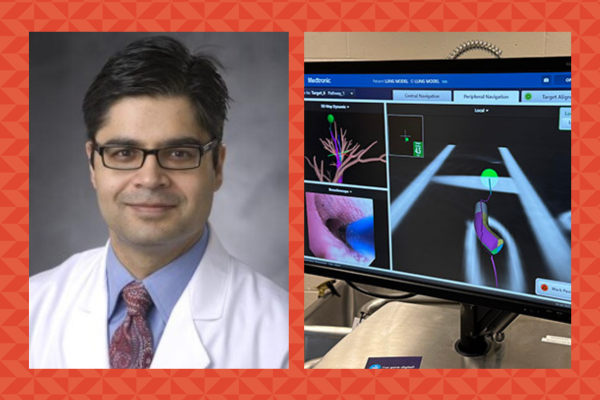
Duke lung cancer patients and their doctors now have better diagnoses options thanks to a new landmark study that fills a critical gap in clinical decisions about which of two main biopsy modalities is better for the diagnosis of lung nodules in patients at moderate to high risk for cancer.
Findings from a multi-center, randomized-controlled trial of 234 patients with lung nodules — the first to ever compare the two main lung biopsy procedures, CT-guided transthoracic needle aspirate with electromagnetic navigational bronchoscopy — showed that electromagnetic navigational bronchoscopy was non-inferior to the transthoracic needle aspirate, and it was associated with fewer complications.
In CT-guided transthoracic needle aspirate, a needle is inserted into the lung lesion from outside under CT scan guidance. In electromagnetic navigational bronchoscopy, a bronchoscope is inserted into the mouth and airways, and a catheter is guided with a “GPS-like” navigation system into the lung nodule and a biopsy is obtained.
Among patients with peripheral pulmonary nodules measuring 10 to 30 mm, diagnostic accuracy of the electromagnetic navigational bronchoscopy was 79% compared to 73% for transthoracic needle biopsy. The diagnostic accuracy was established over a one-year follow-up.
Results were published in the New England Journal of Medicine in June 2025 and co-authored by Kamran Mahmood, MD, MPH, director of interventional pulmonology at Duke University Medical Center and associate professor of Medicine.
“The goal is to make sure that patients are not waiting too long because we want to diagnose and treat lung cancer promptly,” he said. “Patients may choose any modality which is readily available, as both are equally effective. The navigation bronchoscopy platform has evolved further, and newer platforms combine navigational platform with robotic technology.”
Wider Implications
Clinicians like Dr. Mahmood are seeing more lung nodules than ever because of the implementation of lung cancer screening CT scans in patients at risk for lung cancer and incidental finding of lung nodules on CT scans performed for various reasons. While most lung nodules are benign, these are often biopsied in patients at risk for cancer to establish the diagnosis.
Health care systems have to grapple with the expense of developing the necessary infrastructure and clinical expertise to manage the patients with lung nodules.
“Healthcare facilities may have one or both diagnostic modalities available, and need to streamline the patient flow to diagnose the lung nodules as efficiently as possible ,” Mahmood added. “And this has implications for the health insurance providers and policymakers across the health care spectrum.”
There are pros and cons to both approaches, some of which were studied in the trial. Electromagnetic navigation bronchoscopy requires general anesthesia whereas CT-guided transthoracic needle aspirate may be done with either moderate sedation or general anesthesia.
An important complication of the lung biopsy is pneumothorax- when a hole develops in the lung leading to its collapse which may require a chest tube placement and hospital admission.
Pneumothorax was seen in 3% patients who underwent navigational bronchoscopy while 28% patients who underwent transthoracic needle aspirate. Out of these patients, only one patient in the bronchoscopy group but 11% in the transthoracic needle aspirate group required a chest tube placement with subsequent hospital admission.
“As physicians, we want to provide our patients with the best possible medical care which starts with the diagnosis,” Dr. Mahmood said. “Prompt and accurate diagnosis improves outcomes of lung cancer.”
Disclosure: The study was sponsored by Medtronics, the manufacturer of electromagnetic navigational bronchoscope platform, but it had no role in the design, conduct, analysis, and interpretation of the results of the study.